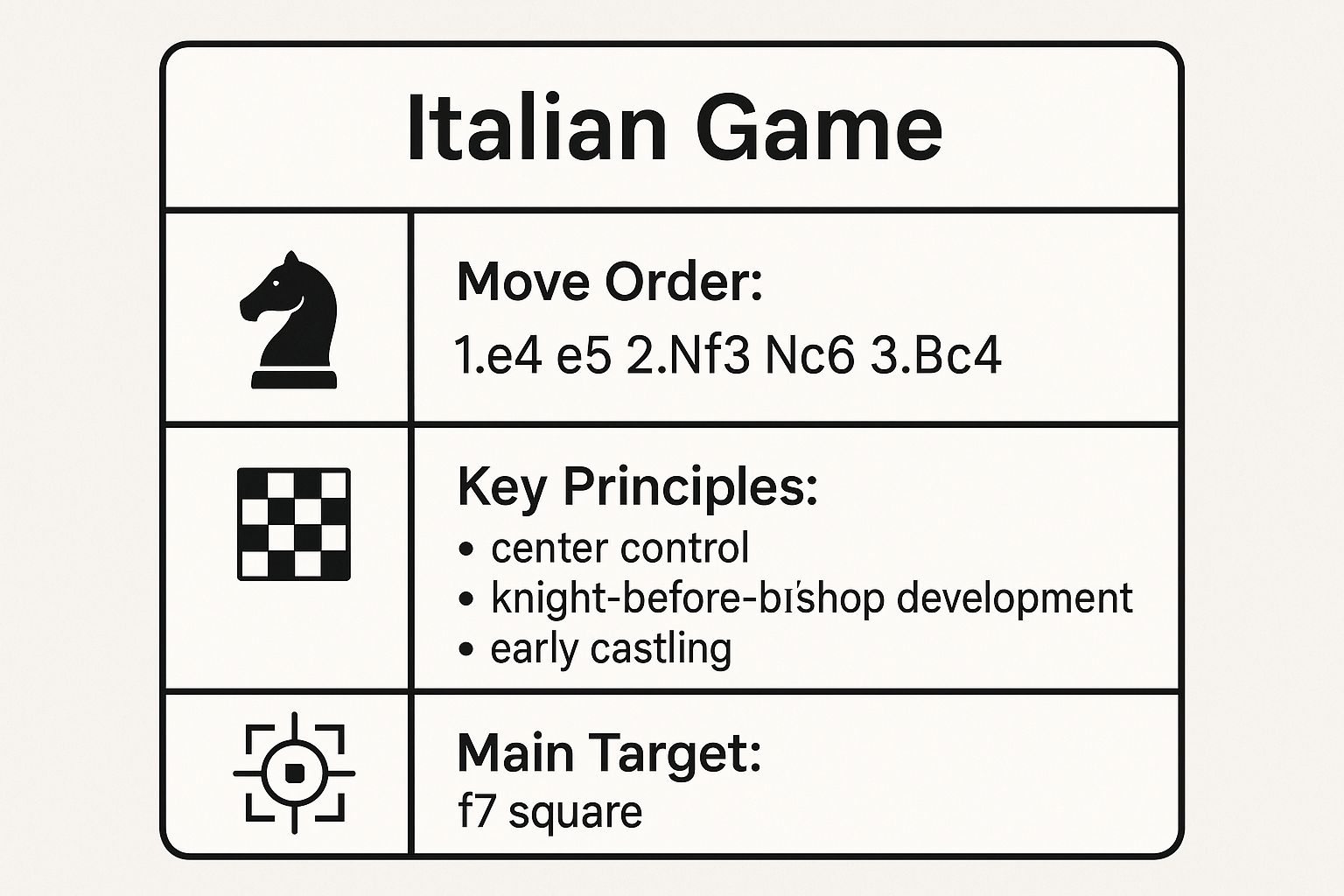Embarking on your chess journey requires a solid understanding of fundamental principles. While grandmasters dedicate lifetimes to theory, a beginner's success starts with a few reliable openings. These initial moves set the stage for the entire game, influencing piece development, central control, and king safety. A well-chosen opening is not about memorizing endless variations but about grasping the strategic ideas that guide your decisions from the very first turn.
This guide will demystify the initial phase of the game, presenting a curated list of the most effective and instructive chess openings for beginners. Each system serves as a gateway to understanding different types of positions, from the tactical skirmishes following 1.e4 to the strategic depth initiated by 1.d4. By learning these foundational structures, you will build a versatile and dependable repertoire that provides a confident start to every match.
This article provides the essential framework to move beyond random pawn pushes and transform your initial moves into a coherent, powerful plan. For players seeking both intellectual challenge and aesthetic appeal, mastering these concepts on a finely crafted chess set can elevate the experience, turning each game into a display of strategic art. Here, you will find the tools to begin your path toward chess mastery.
1. The Italian Game: Classical Principles in Action
The Italian Game stands as one of the most fundamental and enduring chess openings for beginners. It begins with the moves 1.e4 e5 2.Nf3 Nc6 3.Bc4. Its popularity, stretching from the 15th century to modern Grandmaster play, is rooted in its straightforward adherence to classical opening principles. This opening is an exceptional pedagogical tool for novice players seeking to master the core tenets of good play.
By playing 3.Bc4, White immediately develops a piece to an active square. The bishop puts pressure on Black's f7 pawn, which is notoriously weak in the opening as it is defended only by the king. This direct approach teaches beginners about targeting weaknesses, coordinating attacks, and understanding piece activity.
Strategic Goals and Implementation
The primary objective is to establish central control and facilitate rapid, harmonious development. The Italian Game can branch into two main variations, offering diverse strategic experiences:
- Giuoco Piano ("The Quiet Game"): Often leads to a slower, more positional battle where maneuvering and pawn structure become key.
- Giuoco Pianissimo ("The Very Quiet Game"): Characterized by an even more deliberate buildup, focusing on solidifying one's position before committing to a plan.
Regardless of the variation, the initial strategy remains consistent: control the center with pawns and pieces, develop knights before bishops, and prepare to secure your king by castling early.
The following infographic provides a quick reference for the foundational elements of the Italian Game, highlighting its move order, core principles, and a primary tactical focus.

This visual summary reinforces that the opening's strength lies in its logical development scheme and direct pressure on the vulnerable f7-square. Mastering these concepts is crucial, as the tactical motifs that arise are common in many other openings. For a deeper understanding of these tactical patterns, you can explore some essential chess tactics for beginners.
The video below offers a visual guide to the main lines and strategic ideas within the Italian Game, perfect for learners who prefer a dynamic format.
2. Ruy Lopez (Spanish Opening): A Gateway to Strategic Depth
The Ruy Lopez, also known as the Spanish Opening, is arguably one of the most important and deeply studied chess openings for beginners and masters alike. It commences with the moves 1.e4 e5 2.Nf3 Nc6 3.Bb5. Named after the 16th-century Spanish priest Ruy López de Segura, this opening is celebrated for its rich strategic complexity and its adherence to sound positional principles. It offers a fantastic learning ground for understanding long-term strategy and the subtle interplay of pieces.

With 3.Bb5, White develops a piece and immediately puts indirect pressure on Black's e5 pawn by challenging its defender, the knight on c6. Unlike the direct attack on f7 in the Italian Game, the Ruy Lopez initiates a more nuanced, long-term strategic battle. This opening has been a staple in countless World Championship matches and was favored by legends like Fischer, Karpov, and Anand, demonstrating its enduring relevance and strategic richness.
Strategic Goals and Implementation
The core objective for White in the Ruy Lopez is to create lasting positional pressure. White aims to maintain a central advantage and exploit the pin on the c6 knight to create structural weaknesses in Black's position. This opening teaches the value of patience and long-range planning over immediate tactical skirmishes.
Key strategic ideas for players to focus on include:
- Controlling the Center: Both sides fight for dominance in the center, a common theme in all 1.e4 e5 openings.
- Creating Positional Threats: The move 3.Bb5 doesn't pose an immediate threat but creates a long-term problem for Black, who must decide how to resolve the pressure on the knight.
- Pawn Structure Dynamics: The Ruy Lopez leads to many distinct pawn structures, and understanding how to play within them is crucial for success.
- Endgame Advantages: Many lines in the Ruy Lopez can transition into favorable endgames for White, making it an excellent opening for practicing late-game technique.
The Ruy Lopez is less about quick attacks and more about building a solid, advantageous position that can be converted in the middlegame or endgame. Mastering its fundamental concepts will profoundly improve a player's overall strategic understanding.
The video below, presented by International Master Levy Rozman, breaks down the essential ideas and common variations of the Ruy Lopez, providing a clear visual explanation for aspiring players.
3. The Queen's Gambit: Mastering Positional Play
The Queen's Gambit is a cornerstone of chess strategy and one of the most respected chess openings for beginners and grandmasters alike. It begins with the moves 1.d4 d5 2.c4. Unlike its name suggests, it is not a true gambit; White's offered c-pawn can typically be regained with strategic play. This opening is an excellent choice for players who want to explore positional concepts, focusing on long-term advantages rather than immediate tactical skirmishes.
By challenging Black's central d5-pawn with the c4-pawn, White immediately fights for control of the center and opens lines for piece development. This approach, famously highlighted in the Netflix series The Queen's Gambit and played by champions like Vladimir Kramnik, teaches the fundamentals of pawn structures, piece coordination, and strategic planning.

Strategic Goals and Implementation
The central aim of the Queen's Gambit is to create a powerful central presence and apply pressure on Black's position. Black has two primary responses, leading to vastly different types of games:
- Queen's Gambit Accepted (QGA): Black plays 2...dxc4. This leads to an open game where White aims to build a strong pawn center and exploit developmental advantages.
- Queen's Gambit Declined (QGD): Black supports the d5-pawn with 2...e6. This variation results in a more closed, strategic battle where maneuvering and understanding key pawn breaks become paramount.
A fundamental aspect of playing this opening is developing your pieces harmoniously to support your central pawn structure. Focus on controlling key squares, preparing to castle, and creating a cohesive plan based on the resulting pawn formation. The concepts learned here provide a solid foundation for understanding many other d4-based openings.
The following video provides an excellent visual introduction to the core ideas and common variations within the Queen's Gambit, making it accessible for all levels.
4. The Scandinavian Defense: A Direct Challenge
The Scandinavian Defense is a fighting response to White's most popular first move and stands out as one of the more aggressive chess openings for beginners. It begins with the moves 1.e4 d5. Unlike many other openings, Black immediately challenges White's central control, forcing the position open and dictating the game's direction from the very first move. While moving the queen early (after 2.exd5 Qxd5) slightly deviates from classical principles, it gives Black a straightforward path to development and active play.
This opening is an excellent choice for beginners who want to take the initiative and avoid complex, theoretical lines. By playing 1...d5, Black immediately clarifies the central tension, leading to positions where the plans for both sides are often clear and intuitive. It teaches players how to handle an early queen development safely and effectively, a valuable skill in many chess scenarios.
Strategic Goals and Implementation
The primary objective for Black is to disrupt White's central dominance and achieve rapid, active piece development. After the queen recaptures on d5, White typically plays Nc3 to attack the queen, forcing it to move again. The strategic battle then revolves around where Black places the queen and how efficiently they can complete their development.
- Main Line (3...Qa5): The most popular choice, where the queen pins the c3 knight and prepares to support Black's queenside. This often leads to a solid, strategic game.
- Modern Variation (3...Qd6): A flexible alternative that keeps the queen active while preparing to connect the rooks and develop the kingside.
Black's strategy focuses on quick kingside development, often involving ...Nf6, ...Bg4 or ...Bf5, and castling. Learning to neutralize White's lead in development while leveraging the active black queen is the key to success. This opening has been used as a surprise weapon by many strong players and is a favorite in scholastic and club-level tournaments due to its direct nature.
The video below, presented by Grandmaster Varuzhan Akobian, provides a thorough introduction to the key ideas and variations within the Scandinavian Defense, making it accessible for aspiring players.
5. The French Defense: A Solid and Strategic Response
The French Defense is one of the most reliable and highly respected chess openings for beginners and grandmasters alike. It begins after the moves 1.e4 e6. Instead of immediately contesting the center with 1...e5, Black makes a more subtle, solid move, preparing to challenge White's central control with the subsequent ...d5. This opening is celebrated for its strategic depth, resilience, and the rich, complex positions it creates.
By playing 1...e6, Black creates a solid foundation and prepares to fight for the center. The resulting pawn structures are often asymmetrical, which teaches beginners about long-term strategic planning, pawn breaks, and how to play with a space disadvantage. Championed by legends like Mikhail Botvinnik and Viktor Korchnoi, the French Defense is an excellent choice for players who enjoy strategic battles over purely tactical skirmishes.
Strategic Goals and Implementation
The core objective for Black is to undermine White's central pawn on e4 and create counterplay, often on the queenside. This opening leads to closed or semi-closed positions where piece maneuvering and understanding pawn structures are paramount. Key variations include:
- Advance Variation: White plays 3.e5, leading to a locked center where both sides fight for control on the wings.
- Tarrasch Variation: White plays 3.Nd2, a flexible system that avoids the pin from ...Bb4.
- Exchange Variation: White plays 3.exd5, leading to a symmetrical and often drawish position, though it can still harbor subtle complexities.
A primary strategic challenge for Black is the development of the light-squared bishop, which is often hemmed in by the e6 pawn. A crucial part of mastering the French Defense is learning the typical maneuvers to activate this piece. Players should focus on pawn breaks like ...c5 and ...f6 to dismantle White's center and open lines for their pieces.
The video below, presented by a renowned chess coach, breaks down the fundamental ideas behind the French Defense, making it accessible for those new to this robust opening.
6. The Caro-Kann Defense: A Rock-Solid Response
The Caro-Kann Defense is another highly respected and popular choice among chess openings for beginners, initiated by the moves 1.e4 c6. In response to White's central push, Black prepares to challenge for the center with a subsequent ...d5. This opening, named after Horatio Caro and Marcus Kann, is renowned for its reliability and for creating solid, resilient pawn structures.
By playing 1...c6, Black creates a foundation for a central pawn advance without compromising the development of the light-squared bishop, a common issue in the similar French Defense. This approach is perfect for beginners who prefer positional soundness over the wild, tactical complications that can arise from other responses to 1.e4. It teaches the value of structural integrity and patient maneuvering.
Strategic Goals and Implementation
The fundamental objective of the Caro-Kann is to neutralize White's initial advantage by creating an unassailable position. Black aims to achieve a strong pawn center and then develop pieces harmoniously behind this protective shield. The opening often leads to strategically rich middlegames and favorable endgames. Key variations include:
- Classical Variation (4...Bf5): Black develops the light-squared bishop to an active square before closing the pawn chain with ...e6.
- Advance Variation (3.e5): White gains space, but Black immediately puts pressure on the white center, leading to dynamic and complex struggles.
The core strategy involves completing development, controlling key central squares, and understanding typical pawn breaks to open lines for your pieces. Players like former World Champion Anatoly Karpov have masterfully demonstrated the opening's potential for grinding down opponents through superior positional understanding.
The video below explores the main concepts of the Caro-Kann, providing a clear visual explanation of its most important lines and strategic ideas.
7. The London System: A Universal and Solid Setup
The London System is a highly regarded and versatile choice among chess openings for beginners. It is a "system" opening, meaning White can employ a similar setup of pieces against almost any of Black's responses. The opening typically begins with the moves 1.d4 followed by 2.Bf4 and/or 2.Nf3. Its main appeal lies in its solidity, reduced theoretical burden, and clear strategic plans.
This opening provides an excellent framework for newcomers. By developing the dark-squared bishop outside the pawn chain to f4 early on, White creates a robust structure and sidesteps the complex, sharp variations common in other openings. It teaches the value of a systematic approach, positional understanding, and planning, making it an ideal gateway to more advanced strategic concepts without requiring memorization of extensive theory.
Strategic Goals and Implementation
The core objective of the London System is to build a solid central presence and develop pieces to logical squares, leading to a comfortable middlegame. White aims for a stable pawn triangle with pawns on d4, e3, and c3, while the pieces are developed harmoniously behind this structure. The key strategic ideas often revolve around:
- Controlling the e5-square: White's setup naturally exerts pressure on this critical central square, preventing Black from easily dominating the center.
- Creating a Kingside Attack: In many lines, White can launch a potent attack on the kingside, often using the bishop on f4 and knight on f3 as key attacking pieces.
This opening is particularly effective for scholastic players, club players, and anyone wishing to achieve a sound position with good practical chances. Its reliability makes it a formidable weapon in rapid and blitz games, where opponents have less time to find the most precise refutations. Grandmasters like Gata Kamsky have also used it successfully at the highest levels, demonstrating its enduring viability.
The video below, presented by International Master Eric Rosen, offers a comprehensive introduction to the fundamental principles and typical plans within the London System.
Beginner Chess Openings Comparison Table
| Opening | Implementation Complexity 🔄 | Resource Requirements 💡 | Expected Outcomes 📊 | Ideal Use Cases 💡 | Key Advantages ⭐⚡ |
|---|---|---|---|---|---|
| Italian Game | Moderate 🔄🔄 | Low to Medium 💡 | Tactical, rapid development 📊⭐ | Beginners, rapid/blitz games 💡 | Easy to learn ⭐, direct attack ⚡ |
| Ruy Lopez (Spanish) | High 🔄🔄🔄 | High 💡 | Strategic, positional 📊⭐ | Long-term improvement, tournaments | Solid foundation ⭐, rich plans |
| Queen's Gambit | Moderate 🔄🔄 | Medium 💡 | Positional, strategic 📊 | Positional players, all levels 💡 | Strong central control ⭐, versatile |
| Scandinavian Defense | Low 🔄 | Low 💡 | Active, unbalanced positions 📊 | Surprise weapon, active play 💡 | Easy to play ⭐, immediate counterplay |
| French Defense | Moderate to High 🔄🔄🔄 | Medium to High 💡 | Complex, strategic and tactical 📊 | Strategic players, tournament use | Solid defense ⭐, complex middlegames |
| Caro-Kann Defense | Moderate 🔄🔄 | Medium 💡 | Solid, balanced positions 📊 | Positional players, tournament play | Very solid ⭐, reliable equality |
| London System | Low 🔄 | Low 💡 | Solid, consistent setup 📊 | Club players, theory avoiders 💡 | Easy to learn ⭐, flexible against setups |
Building Your Opening Repertoire and Beyond
Embarking on your chess journey by exploring these foundational openings equips you with a formidable and versatile toolkit. This guide has detailed seven of the most respected and effective chess openings for beginners, from the classical duels of the Italian Game and Ruy Lopez to the solid fortifications of the Caro-Kann and French Defenses. We have also examined the strategic depth of the Queen's Gambit and the proactive simplicity of both the Scandinavian Defense and the London System. Each opening offers a unique pathway into the game, built upon timeless principles.
The primary objective is not to memorize every variation presented but to understand the core strategic ideas behind them. Your immediate goal should be to select an opening that aligns with your personal style of play. Do you prefer open, tactical battles or closed, strategic maneuvering? Experiment with these systems to find what truly resonates with you.
Actionable Steps for Mastery
To transition from theoretical knowledge to practical skill, a structured approach is essential. Here are your next steps to building a reliable opening repertoire:
- Choose Your Weapons: Select one opening to play as White (e.g., the Italian Game or the London System) and one or two defenses to play as Black. A good starting point is to have a response ready for both 1.e4 (like the Caro-Kann) and 1.d4 (perhaps transposing a Queen's Gambit Declined setup).
- Practice with Purpose: Play numerous games using your chosen openings. The goal is not just to win but to reach the middlegame in a comfortable and familiar position. Use online platforms or join a local club to gain real-world experience.
- Analyze and Refine: After each game, conduct a brief analysis. Did you follow the main ideas of your opening? Where did you or your opponent deviate? Identifying these moments is crucial for improvement and will deepen your understanding far more than simply memorizing moves.
The Bigger Picture: From Opening to Endgame
Mastering these initial phases is a significant achievement, but it is critical to remember that the opening is merely the first chapter of the game. The true essence of chess mastery lies in the ability to connect your opening strategy to a coherent middlegame plan and execute a precise endgame. The principles highlighted throughout this article, such as controlling the center, developing your pieces rapidly, and ensuring king safety, are the universal truths that will guide you through all phases of the game.
Think of your chosen opening as a launchpad. It provides the initial thrust and direction, but you are the pilot who must navigate the complexities that follow. As you gain more experience, you will begin to recognize recurring patterns, tactical motifs, and strategic themes that extend far beyond the first ten moves. This growing intuition is the hallmark of an improving player. Continue your study, embrace the process of learning from your mistakes, and most importantly, cultivate a deep appreciation for the beautiful logic of chess.
Ready to put your knowledge into practice? Elevate your study and gameplay with a board that inspires strategic thought. Explore the exquisite collection of handcrafted marble chess sets at MarbleCultures, where timeless artistry meets the world’s greatest game. Visit MarbleCultures to find the perfect centerpiece for your home or office and begin your journey to mastery in style.

